A delicious South Indian stew; Sambar is made with lentil, mixed vegetables, sambar masala and tempered with whole spices.
This stew comes together in under 30 minutes and is best with idli, vada, dosa or even steamed rice!

South Indian cuisine is so rich in sides, salads and chutneys. These complete the meal wit a lot of textures, colors and flavors. From the complex ones to the simplest ones; Cilantro Coconut Chutney, Tomato Rasam and Tomato Chutney are definitely the most amazing.
I like to serve these with all kinds of mains including Dosa, Idli, Vada and even Lemon Rice. Along with all these, Sambar is the popular as a side with all the amazing recipes. Sambar is a delicious mix of dal, vegetables (mostly shallots, tomatoes, peas, gourd and pumpkin) and special masala with a flavorful tempering. Healthy, delicious and super satisfying.
Jump to:
What is Sambar
Sambar is literally a lentil stew that is great along with South Indian delicacies like Idli, Vada and Dosa.
Made with toor dal, vegetables and spices, this stew is often medium spicy and full of tangy and savory flavor. We spice it with a special mix called 'Sambar Masala'; which is a mix of dry roasted spices and dal.
Sambar makes a great side for so many South Indian meal. Plus, it pairs brilliantly with steamed rice, quinoa, bisibelebath or lemon rice.
I grew up having a version that my mother made. It was never very spicy, did not have garlic and was made with mixed vegetables that were in the refrigerator. The taste and flavor comes predominantly from the spice mix used and the tempering.
Why this recipe works
- The recipe is naturally Vegan.
- It is a great way to include a lot of lentil i.e. Toor Dal in your diet.
- We can add any vegetable we like for the recipe, or skip them all.
- The recipe is super versatile.
- With one simple care, the recipe for sambar is also gluten-free.
- This pairs perfectly with a ton of South Indian recipes like idli, dosa, vada or even steamed rice or quinoa.
- Sambar comes together in under 30 minutes.
- We can make the sambar ahead of time. It is easy to refrigerate or freeze too.
- This recipe is perfect for meal prep too.
- The spice level in the recipe is easy to control by swapping the chilis for milder ones.
Ingredients and Substitutions
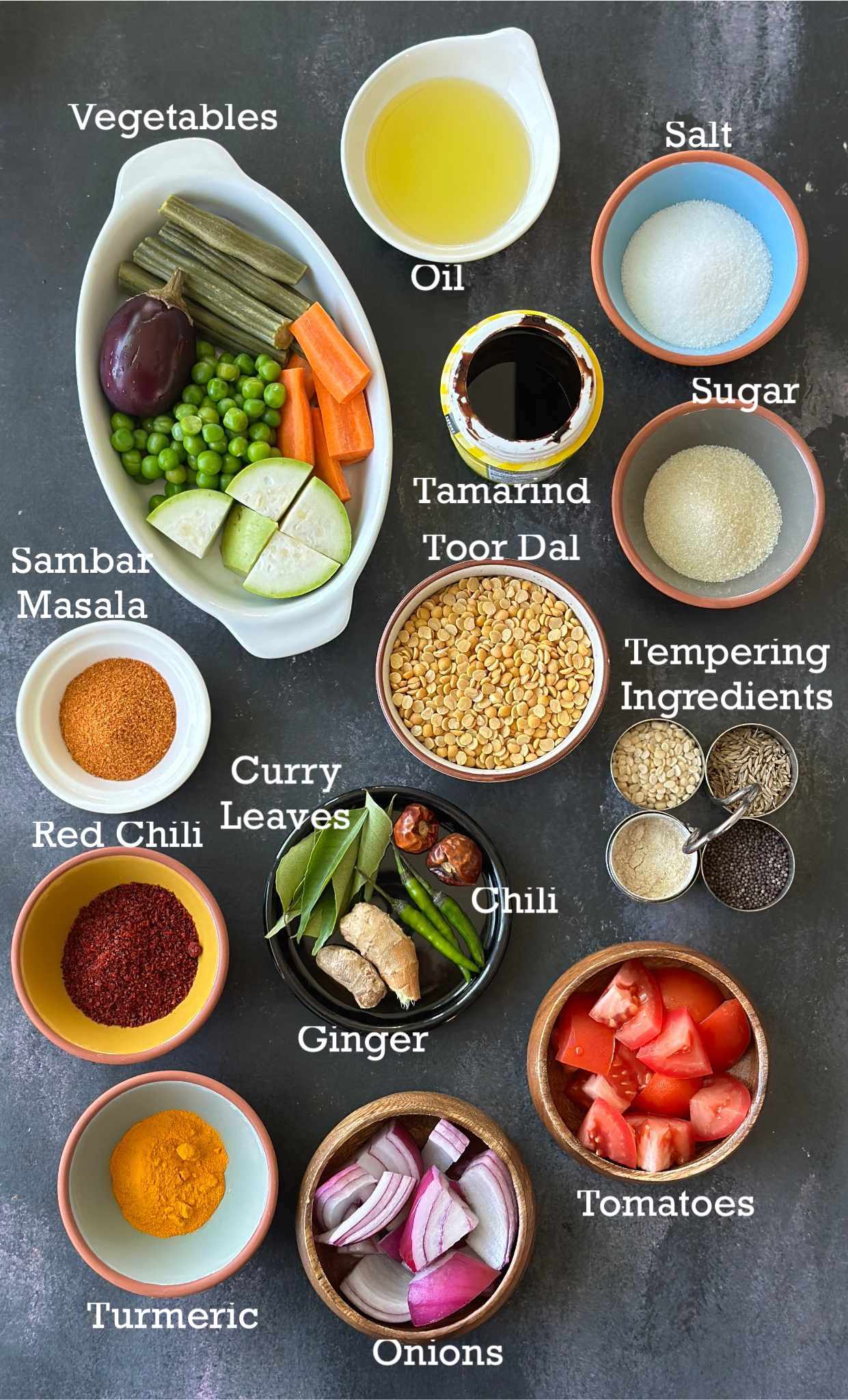
- Dal: I use toor dal to make the sambar. However, making it masoor dal is common too. Make your choice out of these two. The dal needs to be cooked before hand till soft but goopy or mushy. The pressure cooker or instant pot works equally well for this.
- Vegetables: The vegetables that we add can vary from just one to all of them. I switch up the combination based on availability. The most common ones include carrots, pumpkin, bottle gourd, peas, potatoes, eggplant, tomatoes and drumsticks. Either pressure cook them with the dal or boil them as here.
- Sambar masala: A combination of the best spics that go into sambar; this is an essential ingredient. Either store bought or homemade works well here. MTR is definitely a great store bought brand that is flavorful and makes a delicious sambar.
- Tamarind Paste: Another essential ingredient, this may be considered a souring agent only. However, this has a distinct sourness that lemon juice or tomatoes do not impart. If allergic, skip this and add lemon juice.
- Aromatics: For the aromatic, I like to use green chili, ginger and onions. Adding garlic is an option too.
- Spices: Apart from the sambar masala we only need a handful of spices. We spice the sambar with Turmeric powder, red chili powder and salt. A little sugar or jaggery is great to balance the flavors but optional.
- Tempering: Tempering makes all the difference in the recipe. I use mustard seeds, cumin seeds, asafetida, curry leaves, urad dal and chili with hot oil to make the tempering. This is an essential step and I recommend not skipping it.
See the recipe card for detailed ingredient information, measurements and nutrition.
How to make this recipe
1- Wash the dal in running water till the water runs clean. Then transfer to a pressure cooker container. Add water and pressure cook for 3 whistles.
2- Once the pressure releases naturally, open the pressure cooker. Remove the insert and lightly mash the dal using a ladle or spoon. Set aside.

3- In a pan add oil. Heat it up. Add ginger and green chili; mix well.
4- Then add onions. Mix well and cook for 2-3 minutes, till soft.

5- Add in chopped vegetables and peas. Mix well.
6- Add salt and mix well. Also add water.
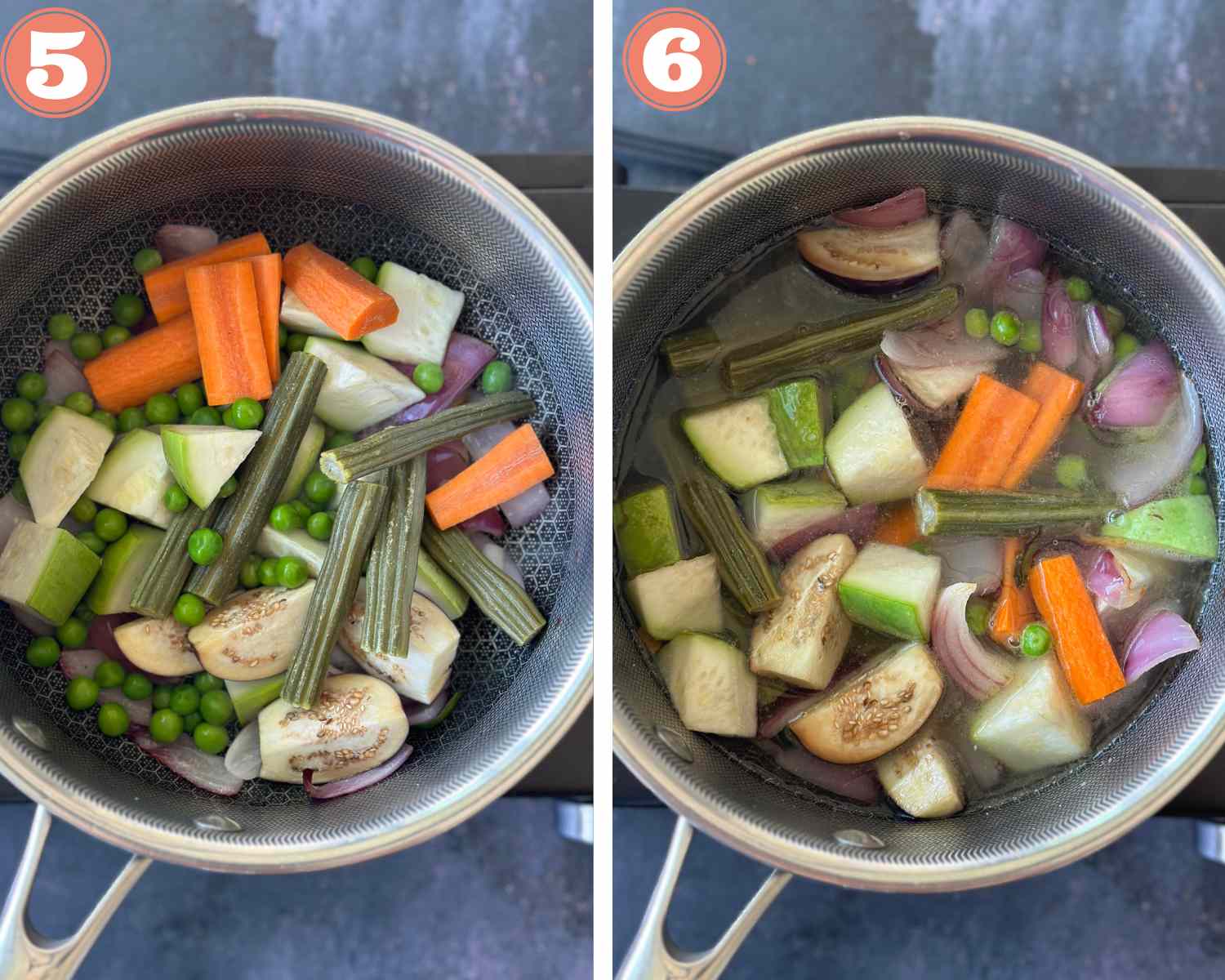
7- Cover and cook for 7-8 minutes; till the vegetables are soft but not mushy.
8- Add in the dal, red chili powder and turmeric powder.
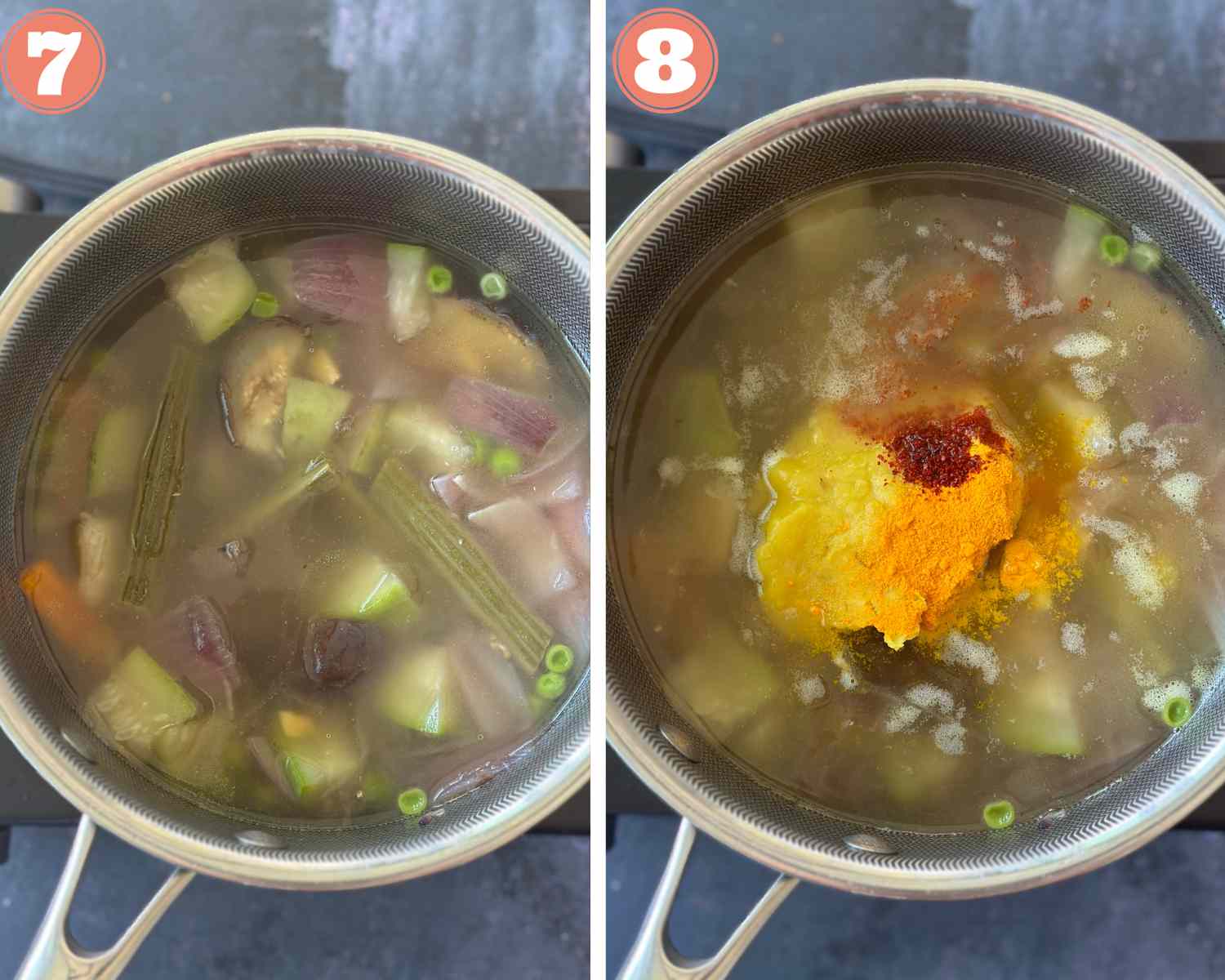
9- Then mix well and bring to a boil.
10- Add in chopped tomatoes and mix well; bring to a rolling boil.
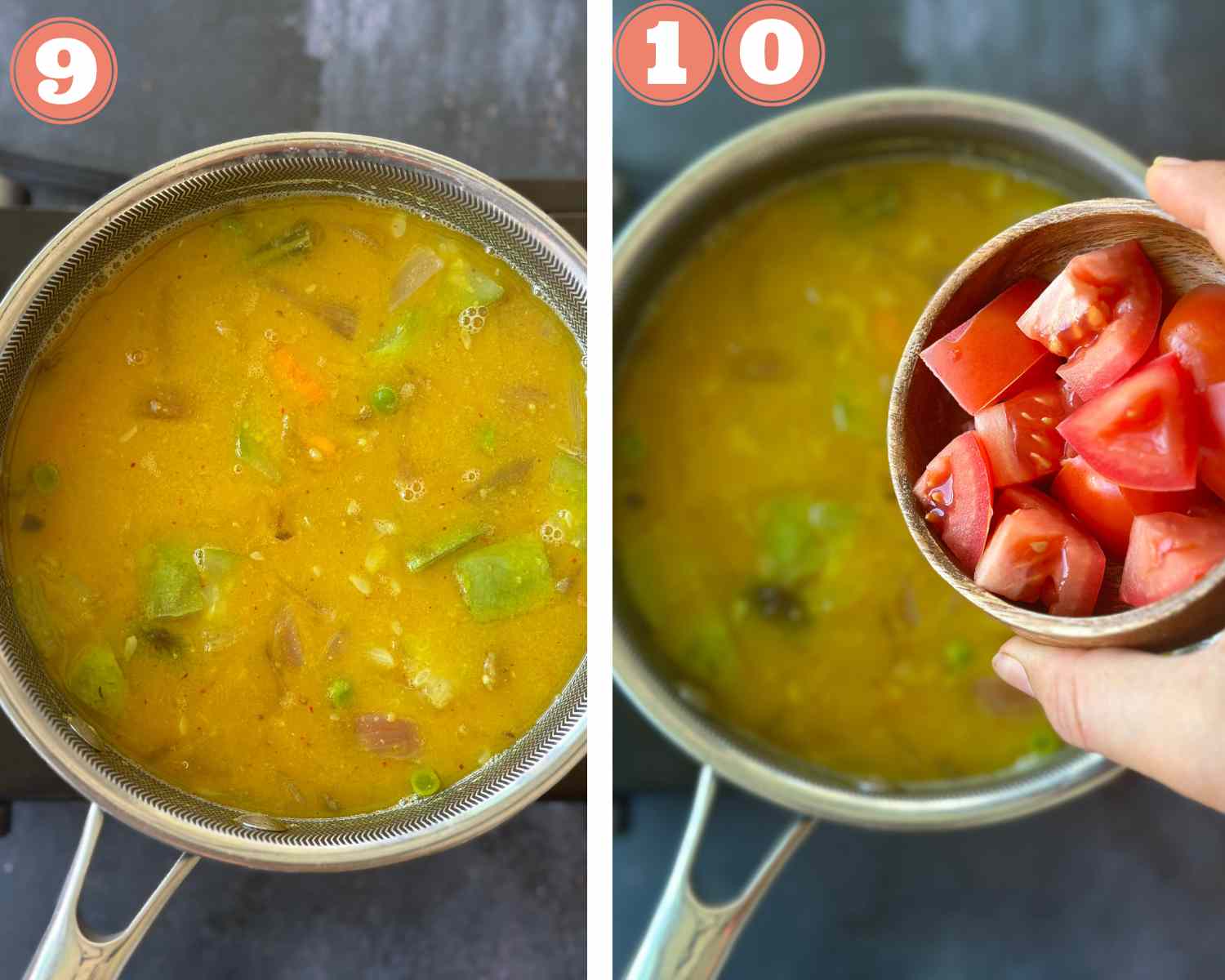
11- In a small pan, heat oil. Once hot add urad dal.
12- As it starts to turn dark, add mustard seeds, cumin seeds, dried chili and curry leaves. Once these pop and add sambar powder. Let the powder cook for 30 seconds but not burn.

13- Then transfer to the sambar and mix well.
14- Boil the sambar for another 5-6 minutes.
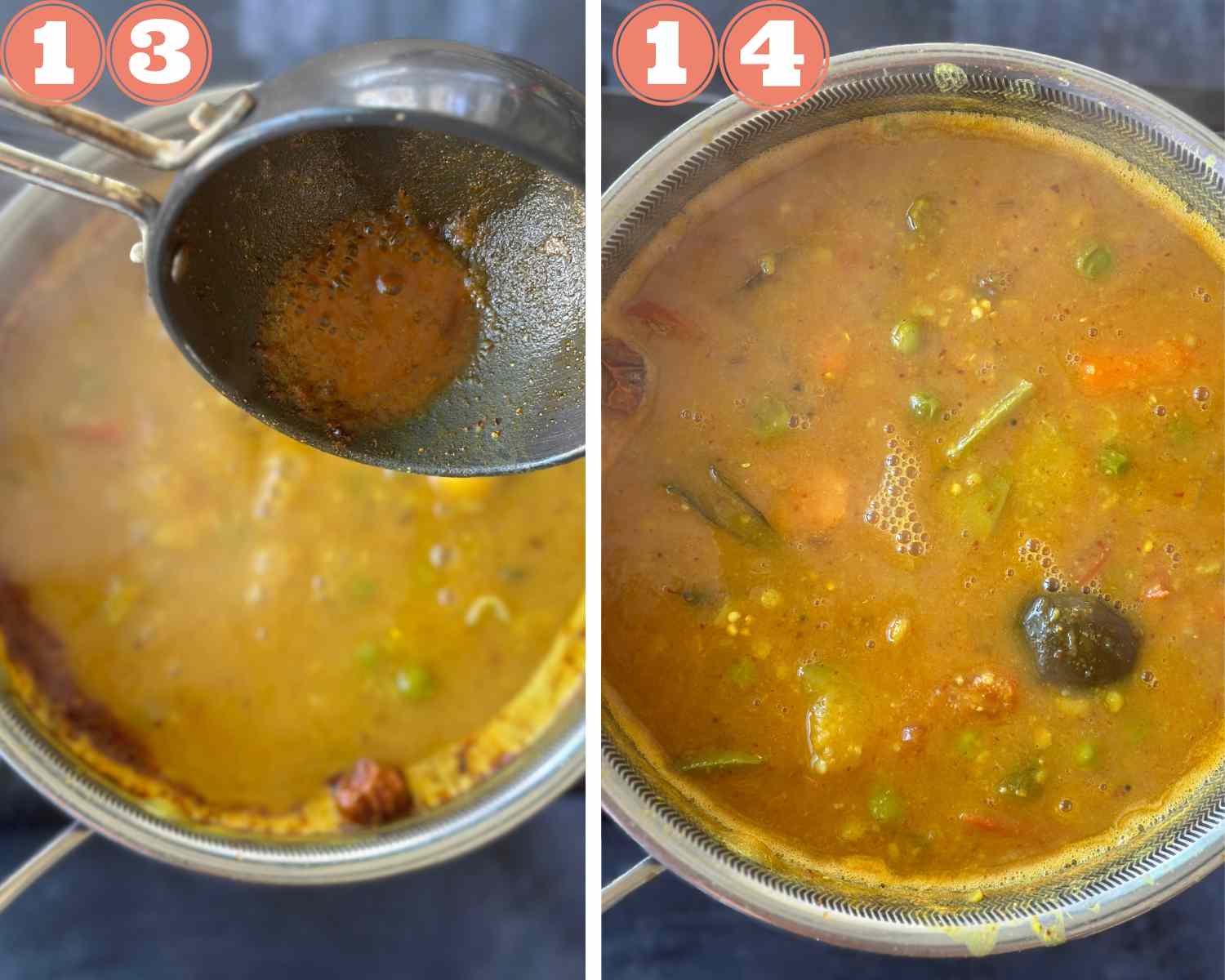
15- Then add tamarind paste and mix well. Turn down the flame.
16- Mix well, top with cilantro and serve with idli, dosa or simply steamed rice.
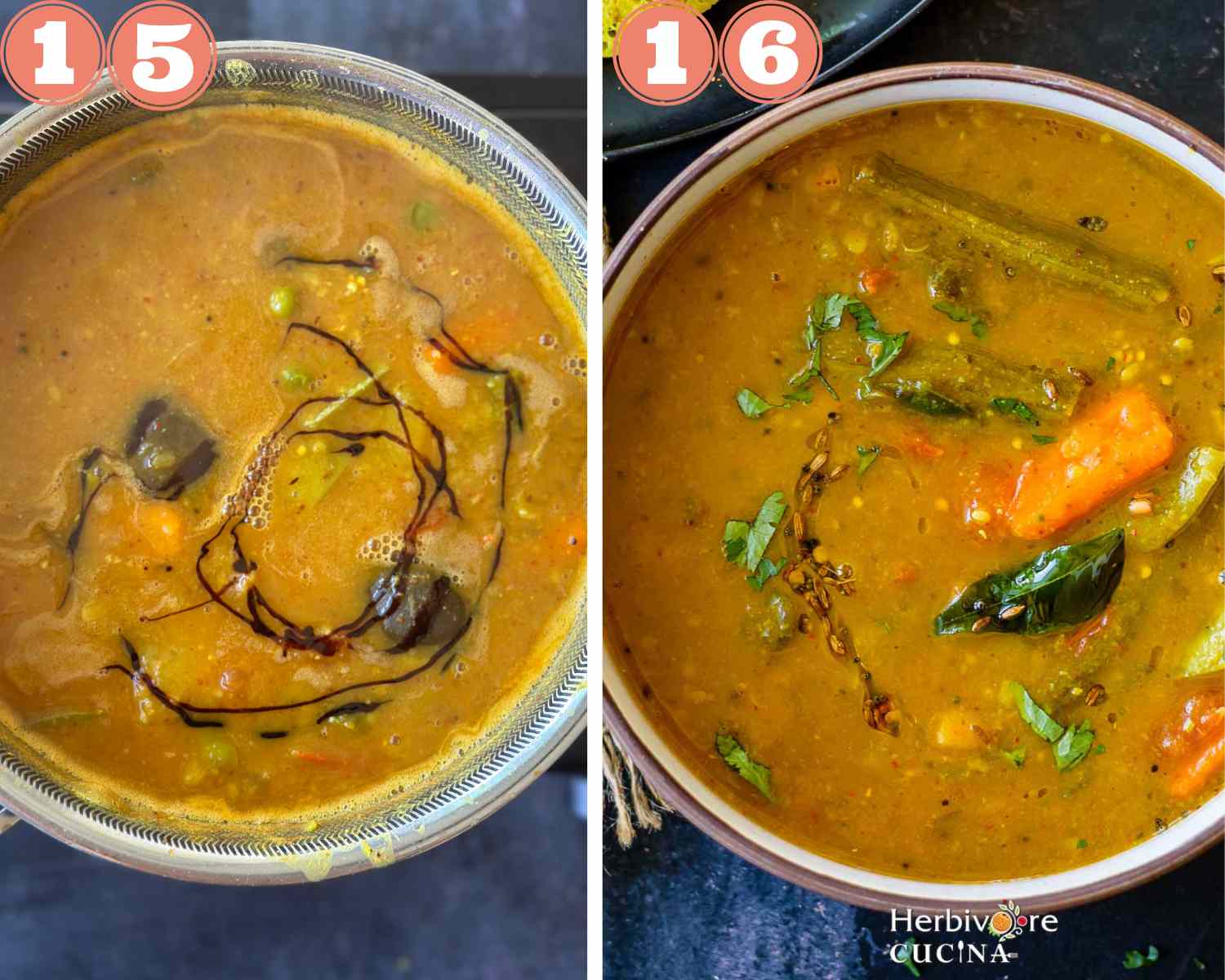
Expert Tips and Notes
- Dal for the sambar: Traditionally toor dal works best for sambar. However, a mix of toor and moong dal works too. Ensure the dal is fresh and not too dated. Dated dal tends to take longer to cook and may still remain grainy.
- Adding vegetables: Seasonal vegetables are great to add in the sambar. All kinds of gourds, okra, beans, potatoes, radish and ivy gourd work well in the recipe.
- Shallots vs onions: Shallots are traditionally perfect in sambar. However, we can easily use pink or white onions instead.
- Adding garlic: Most sambar recipes do not have garlic. However, it can be used if desired. Add it along with ginger and green chili if using.
- Sambar Masala: A special spice mix called sambar masala is used in the recipe. This can be bought from the store or made at home. Plus, remember to add this only after the pressure cooking is done. Over cooking the masala makes the sambar bitter.
- Tamarind: I like to use tamarind as the souring agent in sambar. It has a characteristic sourness that is perfect. Though I would strongly recommend it, replace with lemon juice in case of allergy.
- Storage: Sambar can be served directly after making. The leftover can be refrigerated for 2-3 days in an airtight container. It can also be frozen for up to 3-4 months. Simply heat through before serving. Also, add some water to make it the right consistency.
- Balancing sourness: The sourness of tamarind is perfect to balance with a pinch of jaggery or sugar. It makes the sambar well balanced in taste and gives it the perfect flavors.
Homemade Sambar Powder
Sambar is perfect to make with homemade sambar masala. It is easy to make in a spice blender. The following ingredients are dry roasted and ground to a powder:
- 1 tablespoon chana dal
- 1 teaspoon urad dal
- 2-3 dried red chili
- 1 tablespoon coriander seeds
- 1 teaspoon cumin seeds
- ¼ teaspoon black pepper powder
- 1 teaspoon mustard seeds
- ⅛ teaspoon asafetida
Using the Instant Pot
The instant pot is perfect to use to make sambar too. There are two ways to make it. First is to steam everything together or to steam the dal and then continue on the sauté mode.
I like the first method. Simply sauté the ginger, chili and onions in the base of the instant pot. Then add the raw dal and water and season with salt and turmeric powder. Place a trivet on this and place the vegetables on top. Pressure cook on high for 6 minutes and open the instant pot after the pressure releases.
Then prepare the tempering separately and add it into the dal along with the cooked vegetables. Then add tamarind paste and mix everything well. Enjoy topped with chopped cilantro.
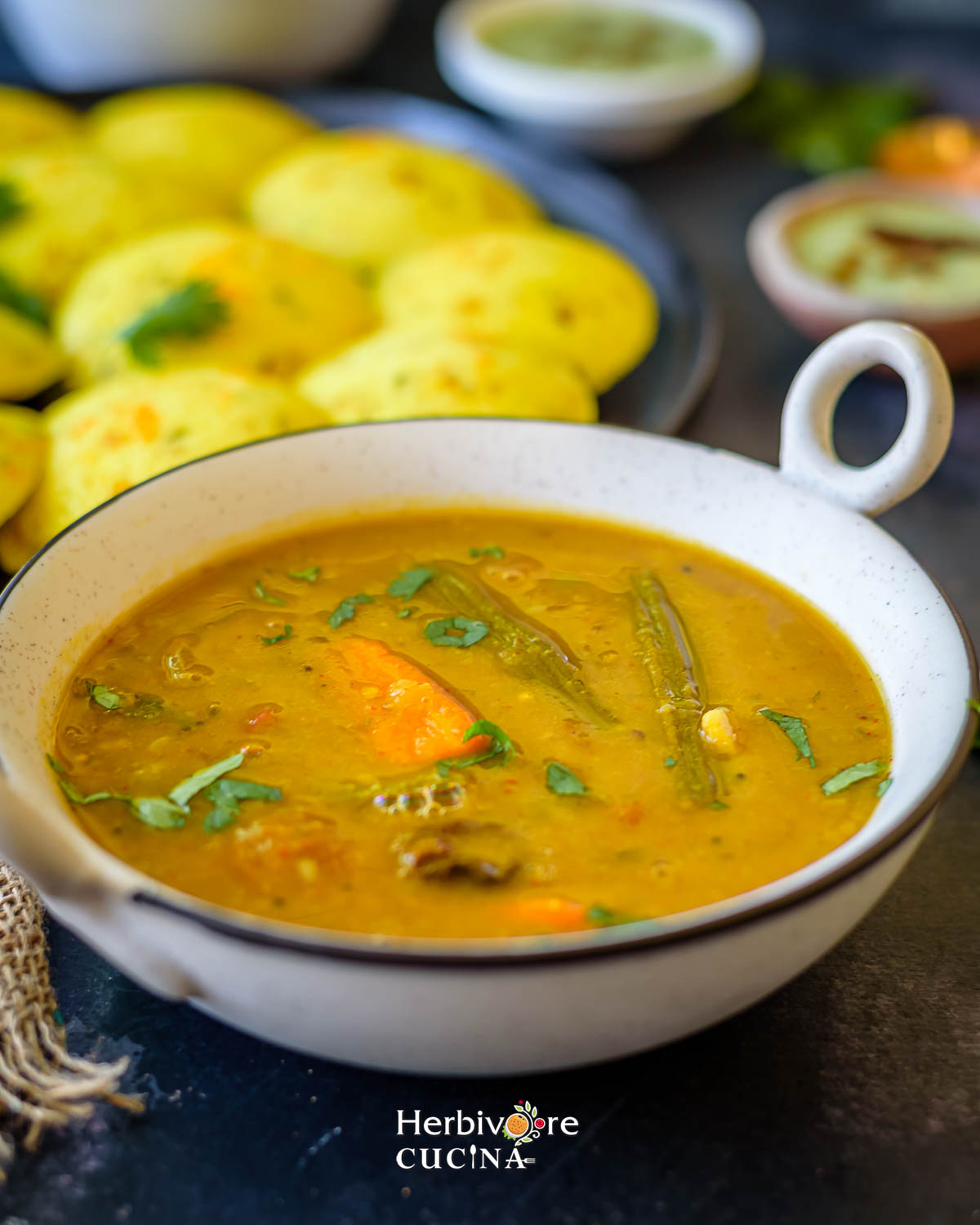
Recipe FAQs
Sambar is a delicious preparation of lentil (toor dal), mixed vegetables, sambar masala and tempering.
Sambar is a tangy, savory stew that pairs wonderfully with idli, dosa or vada. It is popular in South Indian, Sri Lankan and Maldivian cuisines.
Garam masala is a mix of just spices; dry roasted and ground to a powder. In contrast, sambar masala uses spices along with roasted urad and chana dal.
Sambar is a thicker stew that has vegetables. In contrast, rasam is thinner, tangier version with not as many vegetables. Both are South Indian sides that pair with all South Indian recipes though.
Sambar is great to serve with idli, dosa, uttapam, bisibelebath, vada or even steamed rice or quinoa. It is great to serve as a soup topped with cilantro.
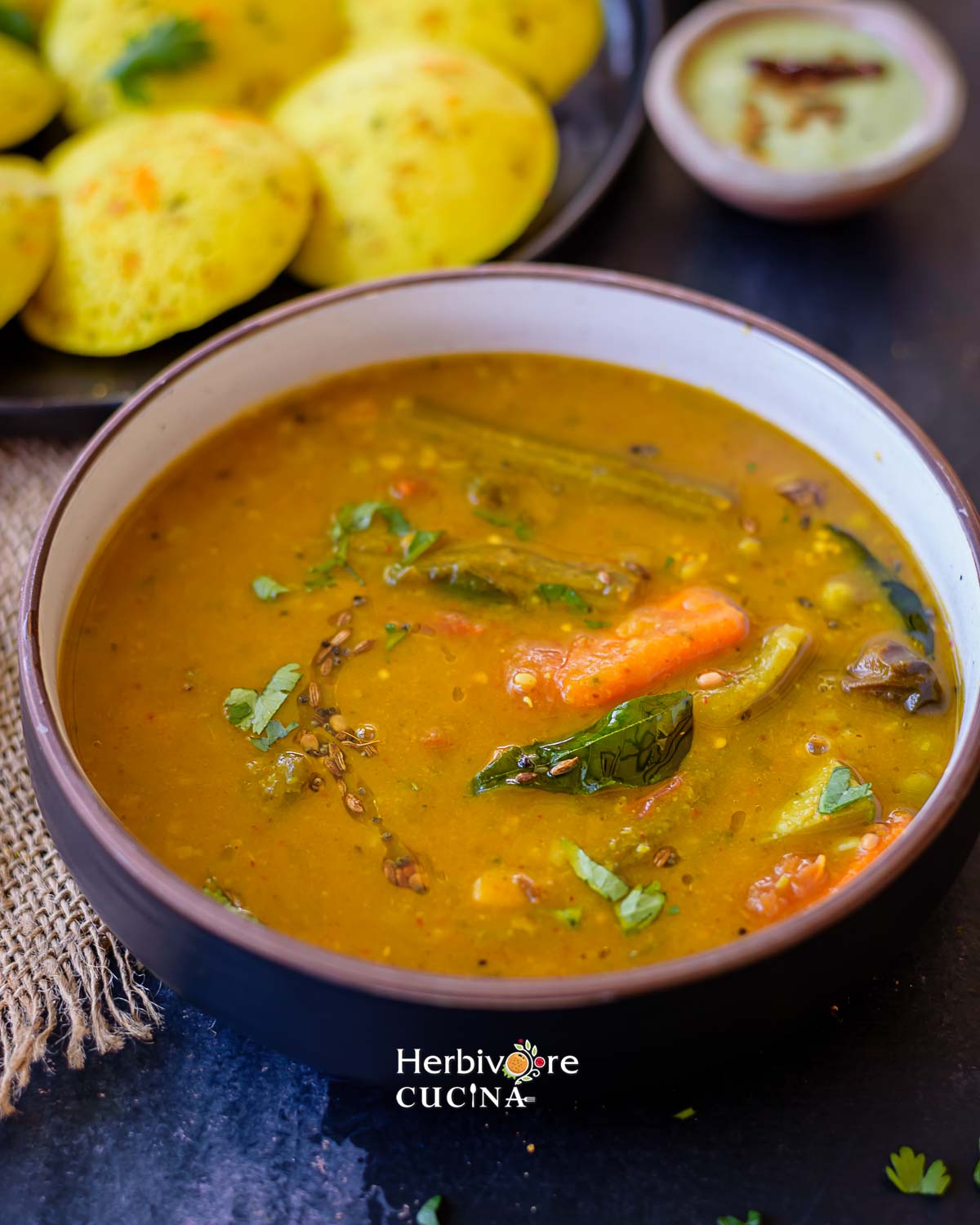
Serving Suggestions
Sambar pairs wonderfully with all kinds of South Indian dishes. Here are some amazing things to serve sambar with. Moreover it is great with some steamed rice, quinoa or even paratha.
More Delicious South Indian Recipes
Love this recipe? Please leave a star rating in the recipe card below & if you REALLY like it, consider a review in the comments whilst you are there, thanks!
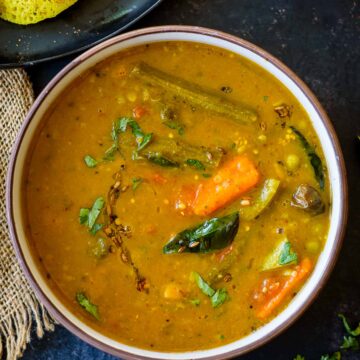
Sambar
Ingredients
For the Dal
- 1 cup toor dal
- 1 cup water
For the Tempering
- 2 teaspoon oil
- ½ teaspoon mustard seeds
- ½ teaspoon cumin seeds
- ⅛ teaspoon asafetida
- ½ teaspoon urad dal
- 3 curry leaves
- 1 dried red chili
For the Vegetables
- 1 medium drumstick
- ½ medium onion
- 1 medium tomato
- 1 small eggplant
- ½ cup bottle gourd
- ½ cup carrot
- ½ cup green peas
- 1 inch ginger
- 1 teaspoon salt
- 1 teaspoon turmeric powder
- 1 teaspoon red chili powder
- 1½ teaspoon sambar masala
- 1 teaspoon sugar
- 1 green chili
- 1½ teaspoon tamarind concentrate
- 1 tablespoon oil
- 1½ cup water
Instructions
- Wash the dal in running water till the water runs clean. Then transfer to a pressure cooker container. Add water and pressure cook for 3 whistles.1 cup toor dal, 1 cup water
- Once the pressure releases naturally, open the pressure cooker. Remove the insert and lightly mash the dal using a ladle or spoon. Set aside.
- In a pan add oil. Heat it up.2 teaspoon oil
- Add the aromatics. Mix well and cook for 2-3 minutes, till soft.1 inch ginger, 1 green chili, ½ medium onion
- Add in chopped vegetables and peas. Mix well.1 medium drumstick, ½ cup bottle gourd, ½ cup carrot, ½ cup green peas, 1 small eggplant
- Add salt and mix well.1 teaspoon salt
- Then add water and mix well.1½ cup water
- Cover and cook for 7-8 minutes; till the vegetables are cooked.
- Add in the dal and dry spices.1 teaspoon turmeric powder, 1 teaspoon red chili powder
- Mix well and bring to a boil.
- Add in chopped tomatoes and mix well. Bring to a rolling boil.1 medium tomato
- In a small pan, heat oil. Once hot add urad dal.1 tablespoon oil, ½ teaspoon urad dal
- As it starts to turn dark, add the remaining spices.½ teaspoon mustard seeds, ½ teaspoon cumin seeds, 3 curry leaves, 1 dried red chili, ⅛ teaspoon asafetida
- Let them all pop and add sambar powder. Let the powder cook for 30 seconds but not burn.1½ teaspoon sambar masala
- Then transfer to the sambar and mix well.
- Boil the sambar for another 5-6 minutes.
- Add tamarind paste and sugar. Then mix well and turn down the flame.1½ teaspoon tamarind concentrate, 1 teaspoon sugar
- Mix well, top with cilantro and serve with idli, dosa or simply steamed rice.
Video
Notes
- Dal for the sambar: Traditionally toor dal works best for sambar. However, a mix of toor and moong dal can be used too. Ensure the dal is fresh and not too dated. Dated dal tends to take longer to cook and may still remain grainy.
- Adding vegetables: Seasonal vegetables are great to add in the sambar. All kinds of gourds, okra, beans, potatoes, radish and ivy gourd work well in the recipe.
- Shallots vs onions: Shallots are traditionally perfect in sambar. However, we can easily use pink or white onions instead.
- Adding garlic: Most sambar recipes do not have garlic. However, it can be used if desired. Add it along with ginger and green chili if using.
- Sambar Masala: A special spice mix called sambar masala is used in the recipe. This can be bought from the store or made at home. Add this only after the pressure cooking is done. Over cooking the masala makes the sambar bitter.
- Tamarind: I like to use tamarind as the souring agent in sambar. It has a characteristic sourness that is perfect. Though I would strongly recommend it, replace with lemon juice in case of allergy.
- Storage: Sambar can be served directly after making. The leftover can be refrigerated for 2-3 days in an airtight container. It can also be frozen for up to 3-4 months. Simply heat through before serving. Also, add some water to make it the right consistency.
- Balancing sourness: The sourness of tamarind is perfect to balance with a pinch of jaggery or sugar. It makes the sambar well balanced in taste and gives it the perfect flavors.

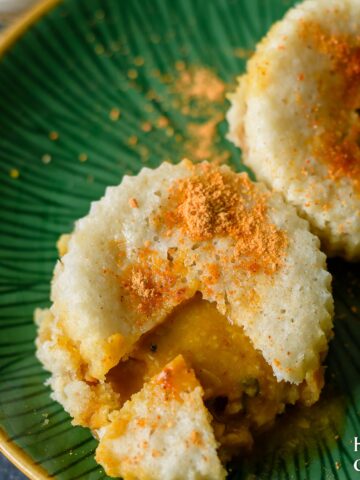

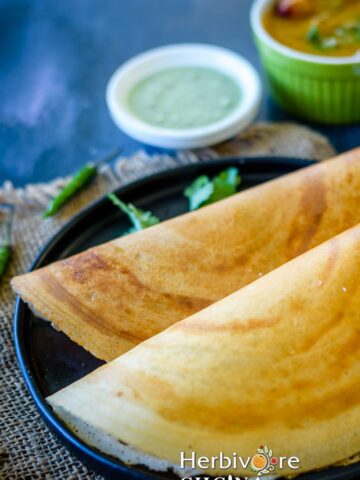

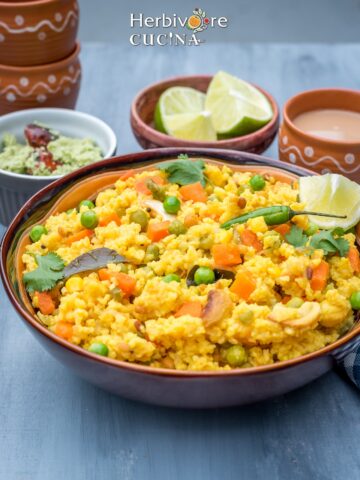
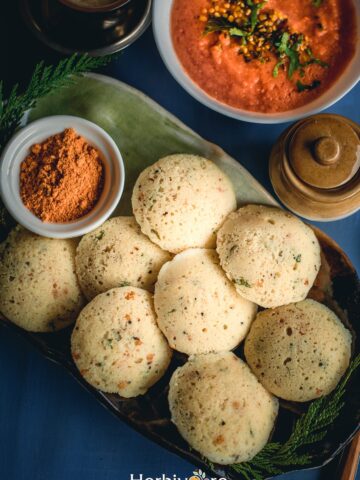
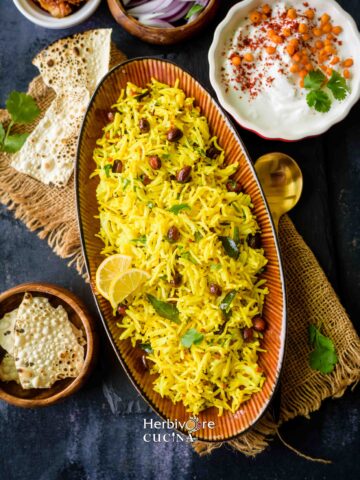
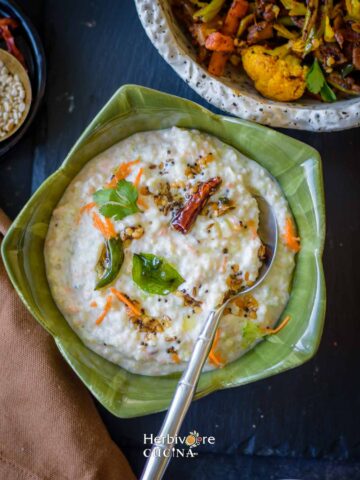
Leave a Reply